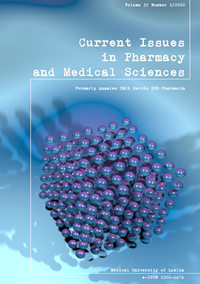The recent guidelines for pharmacotherapy of Parkinson’s Disease
DOI:
https://doi.org/10.2478/cipms-2022-0015Keywords:
Parkinson’s Disease (PD), pharmacotherapy of PD, Dopamine Agonists, Anticholinergic Drugs, future treatment of PDAbstract
Parkinson’s Disease (PD) is one of the most frequent disorders of the central nervous system (CNS). PD is an age-related disease in that morbidity increases with age. The main symptoms of it are motor symptoms like bradykinesia, rigidity and resting tremor. These symptoms diminish the comfort of the patient’s life and may lead to immobility. Hence, rapid diagnosis and start of treatment are very important.
The pharmacotherapy of PD is difficult. PD involves an imbalance between the dopaminergic and cholinergic systems. Therefore, the mechanisms of action of currently available drugs are highly connected with the pathology of PD, and follow dopaminergic or anticholinergic control strategies. However, long-term use of many PD medications comes with serious side effects. Therefore, the search for new, more effective drugs involving different strategies to that current and having different targets is still on-going.
References
1. Edinoff A, Sathivadivel N, McBride T, Parker A, Okeagu C, Kaye A, et al. Chronic pain treatment strategies in Parkinson's disease. Neurol Int. 2020;12(3):61-76.
2. Radhakrishnan DM, Goyal V. Parkinson’s disease: A review. Neurol India. 2018;66(Suppl S1):26-35.
3. Pena-DIaz S, Ventura S. One ring is sufficient to inhibit α-synuclein aggregation. Neural Regen Res. 2022;17(3):508-11.
4. Chagraoui A, Boulain M, Juvin L, Anouar Y, Barrière G, Deurwaerdère PD. L-DOPA in Parkinson’s disease: Looking at the “False” neurotransmitters and their meaning. Int J Mol Sci. 2020;21(1):294.
5. Alborghetti M, Nicoletti F. Different generations of Type-B monoamine oxidase inhibitors in Parkinson's disease: From bench to bedside. Curr Neuropharmacol. 2019;17(9):861-73.
6. Song Z, Zhang J, Xue T, Yang Y, Wu D, Chen Z, et al. Different catechol-O-methyl transferase inhibitors in Parkinson's disease: A bayesian network meta-analysis. Front Neurol. 2021;12:707723.
7. Li BD, Bi ZY, Liu JF, Si WJ, Shi QQ, Xue LP, at al. Adverse effects produced by different drugs used in the treatment of Parkinson's disease: A mixed treatment comparison. CNS Neurosci Ther. 2017;23(10):827-42.
8. Mao Q, Qin WZ, Zhang A, Ye N. Recent advances in dopaminergic strategies for the treatment of Parkinson’s disease. Acta Pharmacol Sin. 2020;41(4):471-82.
9. Carbone F, Djamshidian A, Seppi K, Poewe W. Apomorphine for Parkinson's disease: Efficacy and safety of current and new formulations. CNS Drugs. 2019;33(9):905-18.
10. https://go.drugbank.com/ (access:11.05.2022)
11. Stoker TB, Barker RA. Recent developments in the treatment of Parkinson's Disease. F1000research. 2020;9:F1000 Faculty Rev-862.
12. Ghossein N, Kang M, Lakhkar AD. Anticholinergic medications. In: StatPearls [Internet]. Treasure Island (FL); 2021.
13. Sharma VD, Lyons KE, Pahwa R. Amantadine extended-release capsules for levodopa-induced dyskinesia in patients with Parkinson's disease. Ther Clin Risk Manag. 2018;14:665-73.
14. https://clinicaltrials.gov/ (access:11.05.2022)
15. Yang L, Wang H, Liu L, Xie A. The Role of Insulin/IGF-1/PI3K/Akt/GSK3β Signaling in Parkinson's disease dementia. Front Neurosci. 2018;12:73.
Downloads
Published
Issue
Section
License
Copyright (c) 2022 Authors

This work is licensed under a Creative Commons Attribution-NonCommercial-NoDerivatives 3.0 Unported License.


